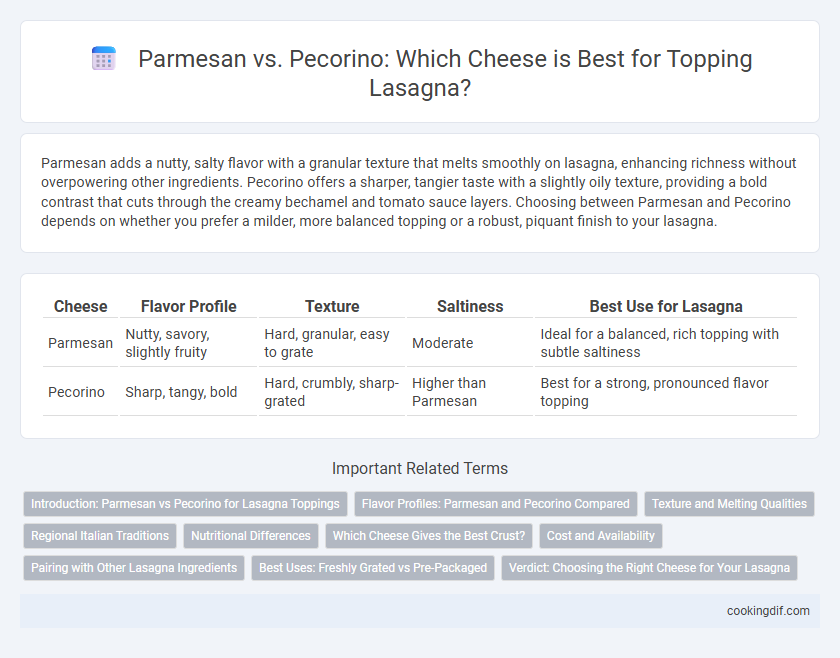Parmesan adds a nutty, salty flavor with a granular texture that melts smoothly on lasagna, enhancing richness without overpowering other ingredients. Pecorino offers a sharper, tangier taste with a slightly oily texture, providing a bold contrast that cuts through the creamy bechamel and tomato sauce layers. Choosing between Parmesan and Pecorino depends on whether you prefer a milder, more balanced topping or a robust, piquant finish to your lasagna.
Table of Comparison
| Cheese | Flavor Profile | Texture | Saltiness | Best Use for Lasagna |
|---|---|---|---|---|
| Parmesan | Nutty, savory, slightly fruity | Hard, granular, easy to grate | Moderate | Ideal for a balanced, rich topping with subtle saltiness |
| Pecorino | Sharp, tangy, bold | Hard, crumbly, sharp-grated | Higher than Parmesan | Best for a strong, pronounced flavor topping |
Introduction: Parmesan vs Pecorino for Lasagna Toppings
Parmesan and Pecorino are two popular cheeses used as toppings for lasagna, each bringing distinct flavors and textures. Parmesan offers a nutty, savory taste with a granular texture that melts smoothly, enhancing the richness of traditional lasagna layers. Pecorino, made from sheep's milk, provides a sharper, saltier flavor that adds a bold punch and complements the tanginess of tomato sauce typically found in lasagna recipes.
Flavor Profiles: Parmesan and Pecorino Compared
Parmesan offers a nutty, savory flavor with a slightly granular texture, enhancing lasagna with a rich umami depth. Pecorino, made from sheep's milk, delivers a sharper, saltier, and tangier profile that adds boldness and complexity to the dish. Choosing between Parmesan and Pecorino depends on whether a milder, buttery finish or a pronounced, piquant kick is desired for the lasagna topping.
Texture and Melting Qualities
Parmesan cheese provides a granular texture and melts to a slightly oily consistency, adding a rich, nutty flavor to lasagna toppings. Pecorino, made from sheep's milk, has a firmer texture and melts less uniformly, resulting in a sharper, saltier taste with a more pronounced bite. The choice between Parmesan and Pecorino impacts the lasagna's overall mouthfeel and flavor profile, with Parmesan offering smoother melt and Pecorino delivering a more robust texture.
Regional Italian Traditions
Parmesan and Pecorino cheeses both enhance lasagna toppings with distinct regional Italian flavors; Parmesan, known as Parmigiano-Reggiano, is traditionally favored in northern regions like Emilia-Romagna for its nutty, granular texture. Pecorino Romano, a sharp, salty sheep's milk cheese, is preferred in central Italian regions such as Lazio and Tuscany, offering a robust taste that complements hearty meat sauces. Choosing between Parmesan and Pecorino reflects authentic Italian culinary heritage, deeply rooted in local cheese production and regional recipes.
Nutritional Differences
Parmesan cheese contains higher levels of calcium and protein compared to Pecorino, making it a richer source of these nutrients for topping lasagna. Pecorino, made from sheep's milk, typically has more sodium and fat content, which can impact overall calorie count and flavor intensity. Choosing between Parmesan and Pecorino for lasagna toppings affects both nutritional intake and taste profile due to these compositional differences.
Which Cheese Gives the Best Crust?
Parmesan creates a golden, crispy crust on lasagna due to its lower moisture content and firmer texture compared to Pecorino. Pecorino, being saltier and sharper, melts differently, resulting in a softer, less crunchy topping. For the best crust, Parmesan is preferred because it browns evenly and adds a rich, nutty flavor.
Cost and Availability
Parmesan is generally more affordable and widely available in most grocery stores compared to Pecorino, which tends to be pricier and found mainly in specialty shops. Parmesan's milder flavor and lower cost make it a popular choice for lasagna toppings without compromising taste. Pecorino, made from sheep's milk, offers a sharper, saltier profile but its limited availability and higher price point can impact accessibility for everyday cooking.
Pairing with Other Lasagna Ingredients
Parmesan offers a nutty, umami-rich flavor that complements the creamy bechamel sauce and tomato-based ragu in traditional lasagna. Pecorino, with its sharper, saltier profile, pairs well with spicy or heavily seasoned meat sauces, enhancing the overall intensity of the dish. Both cheeses melt beautifully but choosing Parmesan favors a balanced, mellow finish, while Pecorino intensifies bold flavors and adds a distinctive tang.
Best Uses: Freshly Grated vs Pre-Packaged
Freshly grated Parmesan offers a rich, nutty flavor and melts smoothly, making it ideal for topping lasagna just before serving to enhance freshness and texture. Pecorino, with its sharper and saltier profile, works best when freshly grated as well, adding a punchy contrast to the creamy bechamel or ricotta layers. Pre-packaged versions of both cheeses tend to lose aroma and flavor intensity, making them less suitable for achieving the authentic taste and optimal melt in lasagna toppings.
Verdict: Choosing the Right Cheese for Your Lasagna
Parmesan offers a nutty, salty flavor that melts smoothly and enhances lasagna with a familiar, mellow richness, making it ideal for classic recipes. Pecorino Romano provides a sharper, tangier taste with a firmer texture, delivering a bold intensity that complements meat or tomato-based lasagnas. Choosing Parmesan or Pecorino depends on whether you prefer a traditional, subtle finish or a more robust, savory punch to elevate your lasagna experience.
Parmesan vs Pecorino for topping Infographic

 cookingdif.com
cookingdif.com